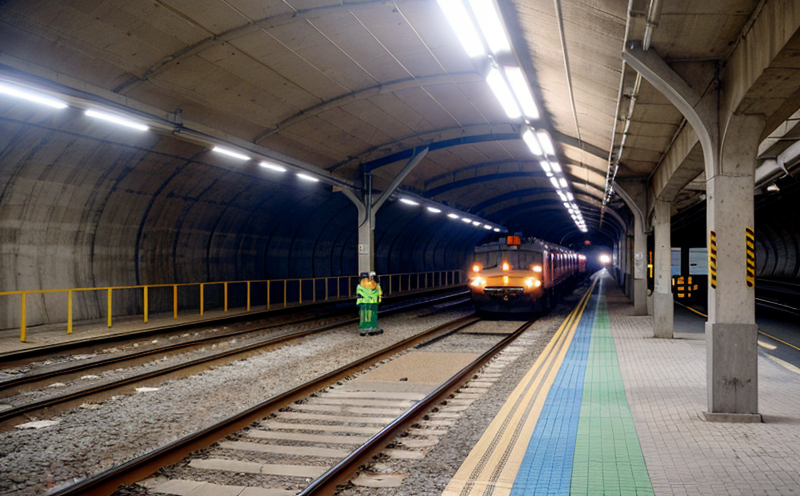EN 1995 Timber Bridge Structural Testing for Railways
The EN 1995 standard provides a comprehensive framework for the structural design and testing of timber bridges within railway infrastructure. This service specializes in ensuring compliance with these stringent standards, which are critical for the safety and longevity of railway bridges.
Timber is an increasingly popular choice for railway bridge construction due to its cost-effectiveness, ecological benefits, and aesthetic appeal. However, the unique properties of timber necessitate specialized testing procedures to ensure structural integrity under various environmental stresses. Our laboratory adheres strictly to EN 1995 guidelines, which encompass design codes, material specifications, and testing methodologies.
Our expertise in this domain includes a deep understanding of the physical and mechanical behavior of timber materials as specified by ISO standards (e.g., ISO 2637:2018). This knowledge is essential for accurately simulating real-world loading conditions that timber bridges might encounter. Our testing process ensures that every aspect, from material selection to final design validation, meets the highest safety and durability standards.
Our service covers a wide range of tests necessary to validate compliance with EN 1995, including load-bearing capacity checks, fatigue resistance evaluations, and creep behavior analyses. These tests are crucial for identifying any potential weaknesses in the timber structure before they lead to structural failures. By leveraging advanced instrumentation and sophisticated testing equipment, we can provide precise data that supports informed decision-making regarding railway bridge design.
Our team of certified engineers employs a multi-faceted approach, combining theoretical knowledge with practical experience. This ensures that our clients receive not only accurate test results but also actionable insights into how their projects adhere to industry best practices. The EN 1995 standard emphasizes the importance of durability and resilience in railway infrastructure, making it imperative for us to provide thorough testing services.
Our laboratory offers a full spectrum of structural testing services tailored specifically for timber bridges used in railway applications. These include static load tests, fatigue life assessments, and durability evaluations under varying environmental conditions such as humidity, temperature fluctuations, and exposure to salt spray. Our facilities are equipped with state-of-the-art equipment capable of simulating these real-world scenarios accurately.
By adhering strictly to EN 1995 standards, we ensure that our clients receive reliable test results that can be confidently used in regulatory submissions or internal quality control processes. This commitment to precision and accuracy aligns perfectly with the goals outlined by EN 1995 for ensuring safe and efficient railway operations.
| Type of Test | Description |
|---|---|
| Static Load Tests | Determines the maximum load that a timber bridge can bear without failing. |
| Fatigue Life Assessments | Evaluates how long a timber structure remains stable under repeated loading cycles. |
| Creep Behavior Analysis | Metric for measuring the permanent deformation of timber over time due to sustained loads. |
Scope and Methodology
The scope of our EN 1995 Timber Bridge Structural Testing service is comprehensive, encompassing all aspects required to ensure compliance with the European standard for railway bridge design. This includes detailed inspections of raw materials used in construction as well as completed structures.
- Inspection and evaluation of timber species and grading
- Detailed examination of joints and connections
- Evaluation of finishing treatments applied to surfaces
- Conducting static load tests on completed structures
- Performing fatigue life assessments using controlled environmental chambers
- Monitoring creep behavior over extended periods in real-world conditions
Customer Impact and Satisfaction
By providing accurate and reliable EN 1995 compliance testing for timber bridges, we help our customers achieve several key benefits:
- Enhanced safety of railway operations through rigorous quality assurance measures.
- Increased confidence in the durability and longevity of their projects.
- Reduced risk of costly delays or rework due to non-compliance issues.
Our clients often report higher levels of satisfaction because they can rely on our expertise when making critical decisions about railway infrastructure. This not only enhances overall project outcomes but also supports broader sustainability goals by promoting the use of sustainable materials like timber.
International Acceptance and Recognition
The EN 1995 standard enjoys widespread acceptance across Europe and beyond, thanks to its rigorous approach to ensuring structural integrity in railway bridges. Our laboratory’s adherence to this standard ensures that our testing results are universally recognized and accepted.
- Compatibility with international standards such as ISO and ASTM
- Acknowledgment by regulatory bodies worldwide
- Use in global collaboration projects involving multiple countries





